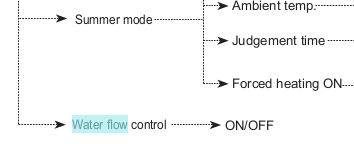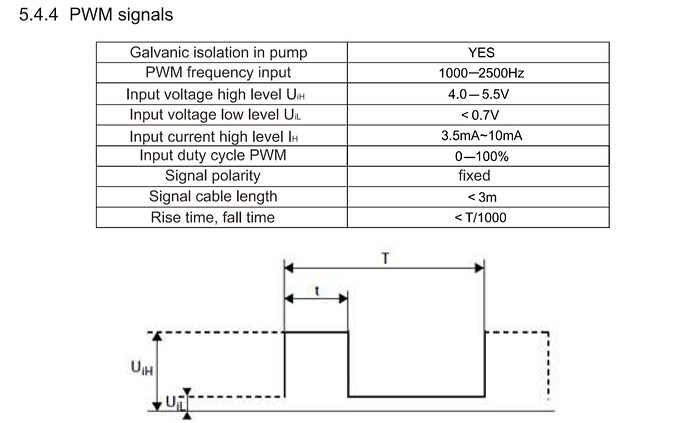That was my next question, anyone know what the connector would be be on the FTC? I have a connector that came with the pump.
BTW my pump is a DUCA TF110
I guess the question we’re all interested in is whether controlling the pump speed via the Ecodan improves performance.
If it does it dynamically based on whatever sensor inputs are deemed relevant then you’d like to think so but if it’s just a means of setting the pump speed on a 1-5 scale probably not.
No I’m fairly sure I’d doesn’t do anything intelligent, just a way to adjust the pump from the controller.
However it does give 5 levels whereas on the pump I can only select 3. And possibly more significantly you can set a different pump speed for DHW and heating.
Only just picked up this thread.
My pumps are driven via the FTC controller - I have a Low Loss Header (though don’t think I need it!), so there are two pumps. As installed, the pumps were not being speed controlled from the FTC. I have added an PWM control cable (there is terminal block in the FTC controller) and connected this to the primary pump. As John said there is no dynamic control of the pump, but I wanted to set a different speed for DHW and heating as I think the pump is running too fast when heating (becuase of the LLH) but if I set the speed down then it struggles with the DHW circuit (probably becuase I have an undersized coil). As others have observed there are settings to do this from the controller. However, I’m unconvinced it actually works as there’s no obervable change in flow rate with different settings in the controller. I’m planning to stick an oscilloscope on the output, but it’s one of those things I’ve not got round to yet!
Regrads
Rachel
How did you identify the plug to use for the terminal block or did you just solder straight to the pins or something else?
I guessed - it took 2 goes! ![]() .
.
The ones I have aren’t quite right, but they do fit and make contact. I’m away at the moment but will try to dig out the type when I’m home. However, I’m unconvinced that the PWM output on the FPC controller actually does anything!
R
| ajdunlop Andrew Dunlop
19 September |
- | - |
Rachel:
I have added an PWM control cable (there is terminal block in the FTC controller) and connected this to the primary pump.
How did you identify the plug to use for the terminal block or did you just solder straight to the pins or something else?
I too have a potentially unnecessary LLH on one of my Ecodan systems. It’s supplied standard with the pre-plumbed units, I guess it makes sense in some system configurations and the pre-plumbed design is a one-size fits all approach.
I’ve been investigating pump control and have come to the same conclusion as this thread that there is very little benefit to having the FTC control the pump speed. It’s dumb control which I’m hoping I can improve on with one of the newer more controllable pumps.
I have two Ecodan systems which are not performing well (oversized/under piped) and so I’m looking at consolidating into a single system and dropping the LLH /replacing pumps etc.
Hi
I also have a pre-plumbed cylinder with a LLH. An engineer came to do a service and said he reckoned it was too small and it needed to be larger…?
I’ve also had a play with the pump speed on my FTC6. Reducing the heating pump speed increased dT for me, but I didn’t touch the other two pumps.
I’m interested here, what settings on the other heating pump did you use to maximise COP and balance the temperatures across the LLH? I know these might be slightly different on my system, but its a starting point at least!
I’ve set my system to run with pump speed 3, mainly to reduce the noise that could be heard around the house, but also to increase the dT from 2 to 5 C. The flow rate measures around 12 l/min, which is technically below the 14 l/min minimum in the spec, but I have doubts that the Sika can measure glycol mix properly. (Heat meter suggests it’s closer to 15 l/min)
I wonder about adjusting the heating circuit pump speed as well so as to balance the LLH, but it sounds like a faff for 10%.
It is indeed a fixed speed, though the manual for FTC6 mentions something called “Water flow control” under Operational settings. I’m not brave enough to try it…

I think what we have might actually be a mere “distribution header” rather than a proper LLH, and its only purpose is to provide hydraulic separation between the heat pump and radiators. As has been suggested above, it’s to make the pre-plumbed cylinder easier to install without having to think too hard about the system design.
From what I understand, increasing the volume in the heating circuit can result in longer cycles. However, it won’t eradicate them entirely, nor does it solve the problems due to an oversized heat pump or insufficient radiator surface area. It might be better to remove the LLH and/or add more radiators.
In what it looks like the future iteration of FTC(FTC7??) it appears that there’s even a setting for a range of temperature difference. So is this setting that everyone has it off by default, the setting that allows the system to manage the flow to achieve a certain dT? As of now everyone says that this doesn’t happen with Ecodan.
A touch screen controller
@Rachel Did you concluded if the flowrate is fixed? I am interested to monitor the energy and if it’s not fixed I would like to do the same as you did and measure it. If it’s fixed, it probably not worth the risk
@pcman I’ve concluded that either the PWM output from the Ecodan isn’t compatible with Grundfos pumps or that it doesn’t work at all. I could probably have checked that with an oscilliscope, but in the end I also wanted to try flow matching the primary and secondary loops, so I built an Arduino controller which I’ve just fitted as per the other thread.
@pcman based on the stats captured by my Kamstrup Multical 403 Heat Meter, the flow rate is almost fixed. I’ve 3 months stats right now.
PWM works fine on my FTC5 with a UPM2 (25-50?). All pump outputs are just relay switched mains, there is a 3 pin connector on the right side of the PCB for PWM and pump feedback (CNPWM).
No advanced controls though, only 1-5 speed setting.
Have been thinking about doing my own controller for the pumps, adjusting pump speed to avoid cycling at lower temperatures and switching to DHW during defrosts to save my old pipes from the hot/cold shocks that makes a lot of noise around the house
I built a controller for my system as it has 2 pumps and I wanted to kind of engineer out the Low Loss Header by making sure the pumps are delivering the same flow rate. See Anyone monitoring a new R32 Ecodan? - #210 by Rachel
I have an EHSC-VM2D with an FTC5.
Do I understand that, as standard, there is no automatic adjustment of speed dependent on flow and return temperatures?
Correct. The Ecodan runs with a fixed flow rate, and does not adjust the flow rate dynamically based on temperatures.
The FTC6 allows different speeds for central heating vs. DHW, but is otherwise the same.

